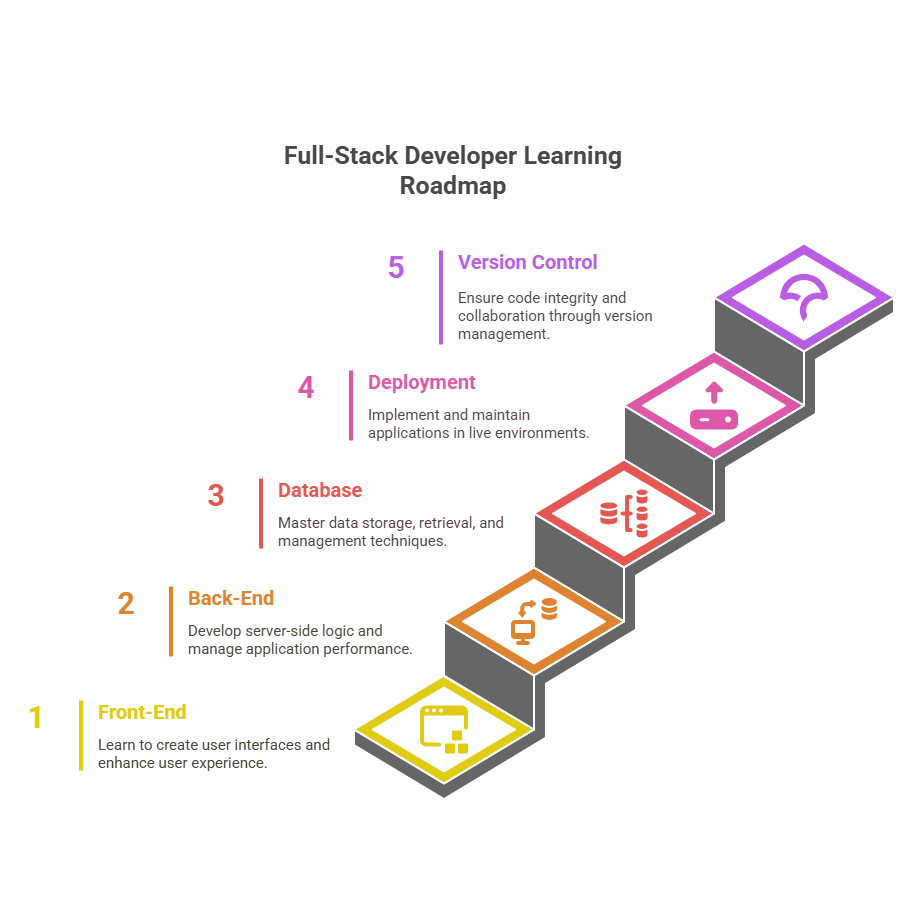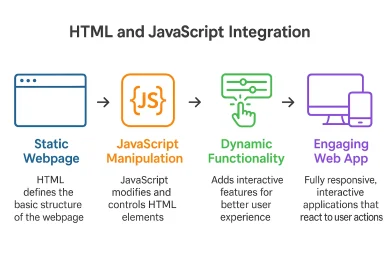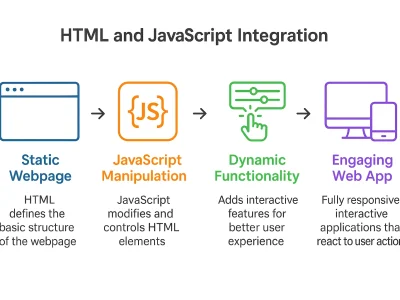Overview of Full-Stack Development
Full-stack development means working on both the front end (what users see) and the back end (the behind-the-scenes logic) of a website or app. To do this, a developer needs to know different technologies that help build a complete, fully functional application.
A full-stack developer is skilled in creating user-friendly designs, handling databases, writing server-side logic, and connecting various tools to make everything work smoothly.
This guide will walk you through the essential skills, technologies, and best practices needed to become a well-rounded full-stack developer, step by step
Why Become a Full-Stack Developer?
As websites and apps get more advanced, companies need full-stack developers who can handle both the front end (what users see) and the back end (how everything works behind the scenes)
Businesses value these developers because they can do it all—from creating user-friendly designs to managing servers and databases. Since they understand the whole development process, they can build fast, scalable applications and help in different areas of a project. This makes them important team members in today’s tech world.
Call to Action: Ready to Start Your Journey? Let’s Dive In!
Start your journey to becoming a full-stack developer by learning the essential skills and following the step-by-step roadmap in this guide
Understanding Full-Stack Development
What is Full-Stack Development?
The full stack could be a layer of a software system or web development consisting of the front-end and back-end parts of associate application. Front-end is what the users can see or interact with on your application. The backend part is what users don’t see, like the application’s logic, database, server, etc. A full-stack web developer is comfortable operating with both back-end and front-end technologies that build a website or application platform properly.
Why Does Full-Stack Development Matter in the Industry?
Full-stack development is crucial in the tech industry due to its versatility, cost-effectiveness, and adaptability. Full-stack developers possess expertise in frontend (UI/UX) and backend (server, database, APIs) development, making them valuable assets for companies needing complete solutions.
Hiring a full-stack developer reduces costs compared to hiring separate frontend and backend specialists, making it ideal for startups and small businesses. Additionally, having a single developer manage the entire stack ensures better coordination, faster product development, and efficient debugging.
Full-Stack vs. Front-End vs. Back-End: Key Differences
The Front-end is the part that users see when they visit websites and applications. Includes elements like:
- Buttons, text, images, and other visual components.
- The layout and design of the application.
- How users interact with the application.
The two most important types of front-end designs are-
- User Experience (UX)
- User Interface (UI)
These things are of different kinds when we get to know them, otherwise, they seem the same. The things, including visual elements, animations, pictures, videos, etc., which look good on the website, are difficult to create as an example of good UI but bad UX and vice-versa;
The back-end is the part that is hidden from the users, but is a part of the development process. Handles all the operations that occur behind the scenes, unseen by the user.
Includes tasks like:
- Storing and managing data in databases.
- Processing user requests and executing business logic.
- Ensuring the application’s functionality and performance.
- Communicating with other systems and services.
Core Skills Every Full-Stack Developer Must Learn
Front-End Development: Building the User Interface
- HTML (Hyper Text Markup Language) – The foundation of a webpage, defining structure and content.
- CSS (Cascading Style Sheets) – The design layer, adding colours, layouts, and animations.
- JS(JavaScript) – The logic and interactivity, making pages dynamic and responsive.
These languages are still used as the most preferred languages in developing web pages and websites because of their major scope in the development industry.
Mastering front-end development involves learning HTML, CSS, and JavaScript for web development. These technologies form the foundation of any web application, enabling developers to create interactive and responsive user interfaces.
Start by mastering the building blocks of the web. Learn HTML, CSS, and JavaScript in depth with Tutedude’s beginner-friendly course.
Back-End Development: Server, Database, and APIs
- Server – The server is the main system that processes user requests, runs business logic and handles workflows
- Examples: Node.js, Apache HTTP Server, Nginx, Microsoft IIS, Tomcat
- Database – The database is where all the data is stored and organized so it can be easily accessed and used.
- Examples: MySQL, PostgreSQL, MongoDB, Firebase, Oracle, SQL Server
- APIs – The interface that connects the front-end, back-end, and other services, allowing them to communicate.
- Examples: RESTful APIs, GraphQL, Google Maps API, Stripe API, Weather API, Twilio API
Version Control & Collaboration (Git, GitHub, Agile Practices)
Version Control Systems
Version control is a way to manage different versions of code, keep track of changes, and maintain a history of updates. This makes it easier to review code, undo mistakes, and collaborate with a team.
Git is one of the most commonly used version control systems. It allows multiple developers to work on the same project, merge their changes, resolve conflicts, and go back to previous versions if needed.
Version control helps teams to work together smoothly by organising tasks and ensuring code is always backed up and easy to recover. It also plays an important role in automated testing and deployment, making software development faster and more efficient.
Distributed Version Control Systems (DVCS)
A Distributed Version Control System (DVCS), like Git or GitHub, is different from centralised systems because it lets every user copy the entire repository, including its full history.
If the main server goes down, anyone with a copy can restore the project, ensuring that work isn’t lost. This built-in backup system makes projects more reliable and secure by allowing development to continue without interruption.
Agile Practices
Agile is a software development method that focuses on teamwork, ongoing customer feedback, and flexibility through short development cycles. Unlike the traditional waterfall model, which follows a long, step-by-step process, Agile encourages small, frequent updates for faster progress and improvements.
Some popular Agile frameworks are:
- Scrum – It is a framework that structures work into short works called “sprints”, using short cycles to gradually improve the project.
- Kanban – Uses visual boards to track progress and ensure a smooth workflow.
Agile has also influenced DevOps, helping teams develop and release software faster and more efficiently while improving collaboration between development and operations teams.
DevOps and Deployment: Automating & Scaling Applications
DevOps is also a software development approach that combines development (Dev) and operations (Ops) to improve teamwork, simplify workflows, and speed up software delivery.
While DevOps and Agile share common goals of improving software delivery and collaboration, DevOps is not a direct replacement or “next version” of Agile, but rather a complementary approach that extends Agile principles to encompass the entire software lifecycle, including operations.
It brings together developers, IT operations, quality engineers, and security teams, removing barriers between them. This helps in building and deploying applications faster and more efficiently while ensuring smooth collaboration across different teams.
- Continuous Integration (CI) & Continuous Delivery (CD)
DevOps practices heavily rely on CI/CD tools to automate and streamline the software development and deployment process, making it faster, more reliable, and efficient software delivery.
- Continuous Integration (CI): CI automatically merges and tests code changes, helping teams find and fix issues early in the development process. Automated tests run within the CI pipeline to maintain code quality, ensuring that only stable and error-free versions move forward.
- Continuous Delivery (CD): CD builds on CI by automating code deployment to different testing and production environments. This keeps software ready for release at all times, allowing for frequent updates that improve stability and security. CD pipelines also integrate monitoring and alerting systems to provide real-time visibility into deployment health and system performance.
As said, by implementing CI/CD, organisations achieve faster development cycles, reduced manual intervention, and greater reliability in application releases.

Learning Roadmap: Your Path to Becoming a Full-Stack Developer
Step 1 – As we already discussed about the core skills used in the Front-end development, Master the Fundamentals (HTML, CSS, JavaScript)
Start with the core building blocks of web development:
- HTML – Structure web pages (tags, forms, tables, semantic HTML).
- CSS – Style and layout (Flexbox, Grid, animations, responsiveness).
- JavaScript – Learn variables, functions, loops, DOM manipulation, and ES6+ features.
Step 2 – Specialize in Front-End Frameworks (React, Vue, Angular)
These frameworks are like pre-built toolkits that help developers quickly and efficiently design the user interfaces, offering reusable components and structures to streamline the development process.
- React.js for Front-End Development – Component-based, used by Facebook, Instagram, and Airbnb.
- Vue.js (Beginner-Friendly) – Simple, lightweight, and great for quick projects.
- Angular (Enterprise-Level) – Robust, TypeScript-based, used by Google and large companies.
Step 3 – Dive Into Back-End Technologies (Node.js, Django, Spring Boot)
The foundation of back-end development begins with selecting a programming language (e.g., JavaScript, Python, Java, PHP, C#), as it dictates the framework, database compatibility, and overall system structure. Once the language is chosen, developers use back-end frameworks (e.g., Express.js, Django, Spring Boot) to simplify development with built-in functionalities.
Next, a database (SQL or NoSQL) is integrated to store and manage data, and APIs make communication between the client and server. Finally, the application is deployed on servers or cloud hosting (e.g., AWS, Nginx, Firebase) to ensure accessibility, scalability, and performance.
Popular Backend Frameworks:
- Node.js + Express.js – JavaScript-based, lightweight, and widely used.
- Django (Python) – Fast, secure, and great for data-heavy applications.
- Spring Boot (Java) – Best for enterprise-grade applications.
Step 4 – Implement Version Control & Project Management
After learning front-end, back-end technologies, programming languages and frameworks, it is time to learn version control systems to integrate the code and track the project changes.
1. Learn Version Control (Git & GitHub/GitLab/Bitbucket):
- Git Basics – Install Git, initialise repositories, commit changes, and manage branches.
- GitHub/GitLab/Bitbucket – Host and collaborate on projects.
- Pull Requests & Merging – Learn how to contribute to open-source and work in teams.
- Rebasing & Conflict Resolution – Handle code conflicts effectively.
2. Learn Project Management:
Finally we need to learn how to adapt to best practices / approaches that deliver the product fastly. As discussed earlier, Agile and DevOps have revolutionized project management practices, disrupting traditional approaches and empowering organizations to deliver value faster.
- Agile & Scrum Basics – Understand how software teams plan and execute projects.
- Kanban Boards – Use Trello, Jira, or GitHub Projects to track progress.
- Tracking Issues & Team Collaboration – Manage tasks, log bugs, and keep track of project goals effectively.
Step 5 – Learn DevOps & Deployment Strategies
1. Learn Deployment & Hosting:
- Deployment and hosting are crucial for making applications accessible to users. Learning deployment strategies helps developers efficiently move applications from local environments to production servers. Hosting options include cloud services (AWS, Azure, Google Cloud), traditional web servers (Apache, Nginx), and serverless solutions (AWS Lambda, Firebase Functions). Containerization tools like Docker and Kubernetes simplify deployment by ensuring consistency across environments.
2. Learn Infrastructure & Monitoring:
Infrastructure and monitoring are essential for maintaining a stable, scalable, and high-performing application. Learning infrastructure management involves using tools like Terraform, Ansible, and Kubernetes to automate server provisioning, scaling, and configuration. This ensures that applications run efficiently across different environments.
Monitoring tools like Prometheus, Grafana, Datadog, and the ELK Stack help track system performance, detect issues, and analyze logs in real time. Proper monitoring enhances security, optimizes resource usage, and ensures high availability. By mastering infrastructure and monitoring, developers can proactively manage system health and prevent downtime, making applications more reliable and scalable.
Common Challenges & How to Overcome Them
Becoming a full-stack developer is rewarding but comes with challenges. Here’s how to tackle them effectively:
- Overwhelming Tech Stack: Too many languages, frameworks, and tools to learn.
- Debugging Complex Issues: Tracking bugs in large applications is difficult.
- Managing State in Frontend: Handling complex UI states can be tricky.
- Handling Backend Security: Protecting against SQL injection, XSS, and CSRF attacks.
- Deploying & Scaling Applications: Deployment can be confusing with cloud providers and CI/CD tools.
- Staying Updated with Technology Changes: New updates, frameworks, and best practices emerge constantly.
Career Growth & Industry Trends for Full-Stack Developers
Full-Stack Developer Salaries & Job Market Demand
The information provided is based on various sources detailing full-stack developer salaries and job market demand:
- United States: The average salary for a full-stack developer is approximately $126,626 per year, with additional cash bonuses averaging $5,500 annually.
- India: The average salary for a full-stack developer is approximately ₹793,000 per year.
These figures highlight the strong demand and competitive compensation for full-stack developers across different regions.
Future Trends in Full-Stack Development
- Low-Code Development: The rise of low-code platforms is simplifying application development, allowing developers to build applications faster with minimal hand-coding.
- Artificial Intelligence (AI): Integrating AI into applications is becoming more prevalent, enabling features like personalised user experiences and intelligent data analysis.
- Internet of Things (IoT): Full-stack development is expanding to accommodate IoT applications, requiring developers to handle data from interconnected devices and ensure seamless communication between hardware and software components.
- Blockchain Technology: There’s a growing interest in incorporating blockchain for secure and transparent transactions, leading developers to integrate decentralised technologies into their applications.
- Progressive Web Applications (PWAs): PWAs are gaining traction as they offer native app-like experiences directly through web browsers, enhancing user engagement without the need for app store downloads.
These trends indicate a shift towards more efficient, intelligent, and user-centric application development in the full-stack landscape.
Resources to Learn & Stay Updated
Best Online Courses & Tutorials for Full-Stack Development
Platforms like Coursera, Udemy, and freeCodeCamp offer comprehensive courses on full-stack development. These resources provide structured learning paths and hands-on projects.
- Online Courses & Bootcamps
- Books
- Eloquent JavaScript by Marijn Haverbeke (JavaScript fundamentals)
- You Don’t Know JS by Kyle Simpson (Deep Dive into JavaScript)
- Full Stack JavaScript by Azat Mardan (Covers Node.js, Express, and MongoDB)
- Documentation & Official Guides
- YouTube Channels
Join Developer Communities & Networking Groups
Connecting with other developers is crucial for learning, staying updated, and getting career opportunities. Here are the best developer communities & networking platforms to join
1 ) GitHub – Contribute to Open Source
2 ) Stack Overflow – Get Coding Help
3 ) Reddit – Join Tech Subreddits
4 ) LinkedIn & Twitter – Follow Industry Experts
5) Meetups & Hackathons – Attend Developer Events
Hands-on Projects to Build Your Portfolio
Building a portfolio of projects is crucial for showcasing your skills. Work on real-world projects, contribute to open-source and create personal projects to demonstrate your expertise.
- LeetCode – Algorithmic coding and backend problem-solving.
- GitHub – Hosting full-stack projects and contributing to open-source.
- Frontend Mentor – Real-world frontend challenges.
- FreeCodeCamp – Hands-on coding projects.
Pro Tips for Becoming a Successful Full-Stack Developer
Productivity Hacks for Full-Stack Developers
Embrace Modular Development
One of the most effective ways to improve productivity as a full-stack developer is to adopt a modular development approach. Modular development involves breaking down your application into smaller, reusable components, making it easier to develop, test, and maintain. By structuring your code into modules, you ensure that each component has a single responsibility, reducing complexity and improving efficiency.
A modular approach allows multiple developers to work on different features simultaneously, accelerating the development process. It also reduces code duplication, making debugging and updates more manageable. Additionally, modular components can be reused across different projects, saving development time in the long run. By leveraging frameworks like React for frontend development and Express.js for backend APIs, developers can efficiently create modular, scalable applications.
Utilise Version Control Systems
A Version Control System (VCS), such as Git, is an indispensable tool for full-stack developers. It helps track code changes, collaborate with team members, and maintain different versions of the project. Using GitHub, GitLab, or Bitbucket ensures that your code is stored safely, allowing you to revert to previous versions if needed.
Implementing best practices like creating feature branches, making atomic commits, and writing clear commit messages improves workflow efficiency. Teams can leverage pull requests for code review, ensuring higher code quality before merging changes into the main branch. Additionally, integrating Git with CI/CD pipelines further automates testing and deployment, reducing manual effort and minimising errors.
Automate Testing and Deployment
Automation is a game-changer for full-stack developers, streamlining workflows and reducing human error. Automated testing ensures that code changes do not introduce bugs, while automated deployment eliminates the hassle of manual updates.
Key strategies for automation
- Implement unit tests using frameworks like Jest, Mocha, or PyTest to catch errors early.
- Use end-to-end testing tools such as Cypress or Selenium to validate user interactions.
- Adopt Continuous Integration (CI) practices with tools like Jenkins, Travis CI, or GitHub Actions to automate code testing before merging.
- Leverage Continuous Deployment (CD) pipelines to deploy applications seamlessly using AWS, Netlify, or Vercel. By integrating these automation tools into your workflow, you ensure that your applications remain stable, efficient, and production-ready with minimal effort.
Utilise Containerisation with Docker
A common challenge in full-stack development is ensuring that applications run consistently across different environments. Containerization with Docker solves this problem by packaging your application with all its dependencies, ensuring smooth deployment across various platforms.
Benefits of using Docker
- Eliminates the “works on my machine” problem by maintaining consistency across development, testing, and production environments.
- Simplifies scaling and microservices architecture, making it easy to deploy and manage multiple services independently.
- Works seamlessly with Kubernetes for efficient container orchestration and scalability.
- Reduces setup time, allowing developers to focus on writing code rather than troubleshooting environment issues.
- By integrating Docker into your workflow, you can enhance your development efficiency, improve deployment reliability, and minimize downtime.
Agile Development Practices
Adopting Agile development methodologies is crucial for optimizing productivity. Agile approaches, such as Scrum and Kanban, promote flexibility, collaboration, and iterative development, ensuring a structured yet adaptable workflow.
By embracing Agile principles, full-stack developers can efficiently manage projects, collaborate effectively, and deliver high-quality applications on time.
Prioritise Code Optimisation and Performance
Efficient code leads to faster execution, reduced server load, and a better user experience. Optimising code and performance should be a key focus for full-stack developers.
Performance optimisation hacks
- Minimise HTTP requests and use lazy loading to speed up page load times.
- Optimise database queries using indexes, caching (Redis, Memcached), and connection pooling.
- Compress assets like images, CSS, and JavaScript files to improve website speed.
- Utilise asynchronous programming (e.g., async/await in JavaScript) to handle multiple tasks efficiently.
- Leverage content delivery networks (CDNs) to distribute static files globally for faster access.
- By proactively optimising performance, developers can create seamless and high-performing web applications.
Leverage AI-Powered Development Tools
Artificial Intelligence (AI) is transforming software development by automating repetitive tasks and enhancing code quality. AI-powered tools can boost productivity by assisting with code completion, bug detection, and documentation.
Popular AI tools for full-stack development
- GitHub Copilot – AI-powered code suggestions to speed up development.
- Tabnine – AI-driven autocompletion for faster coding.
- SonarQube – Automated code review and quality analysis.
- ChatGPT & Bard – AI assistants for debugging and learning new concepts.
By integrating AI tools into the development workflow, full-stack developers can accelerate coding, improve code quality, and reduce development time.
Mistakes to Avoid in Your Full-Stack Journey
Becoming a full-stack developer requires mastering multiple technologies, but many developers make mistakes that slow their progress. Here are some mistakes to avoid,
- Learning Too Many Technologies at Once
- Skipping Fundamentals (HTML, CSS, JavaScript)
- Avoiding Backend & Database Knowledge
- Not Using Version Control (Git/GitHub)
- Ignoring Best Practices in Code Structure
- Not Practicing Enough Real-World Projects
- Ignoring Performance Optimization & Security
- Not Staying Updated with Industry Trends
Conclusion
Becoming a full-stack developer is a rewarding journey that offers numerous opportunities for growth and innovation. By following this roadmap and continuously honing your skills, you can excel in this dynamic field.




